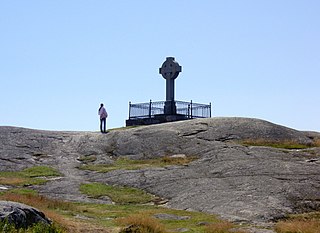
Birkalisten (help·info), on the island of Björkö in present-day Sweden, was an important Viking Age trading center which handled goods from Scandinavia as well as many parts of the European continent and the Orient. Björkö is located in Lake Mälaren, 30 kilometers west of contemporary Stockholm, in the municipality of Ekerö.

Lejre is a railway town, with a population of 3,127, in Lejre Municipality on the island of Zealand in east Denmark. It belongs to Region Zealand. The town's Old Norse name was Hleiðr or Hleiðargarðr.
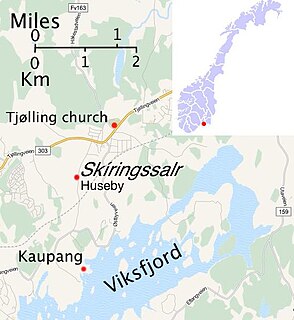
Kaupang was a Norse term for market-place. Today, it is generally used as a name of the first town-like market-place in Norway, the Kaupang in Skiringssal, which is located in Tjølling near Larvik in Vestfold. Kaupang was an important merchant and craft center during the Viking period and as yet the first known Norwegian trading outpost.

Lindholm Høje is a major Viking burial site and former settlement situated to the north of and overlooking the city of Aalborg in Denmark.

The Oseberg ship is a well-preserved Viking ship discovered in a large burial mound at the Oseberg farm near Tønsberg in Vestfold og Telemark county, Norway. This ship is commonly acknowledged to be among the finer artifacts to have survived from the Viking Era. The ship and some of its contents are displayed at the Viking Ship Museum at Bygdøy on the western side of Oslo, Norway.

The Ladby ship is a major ship burial at the village of Ladby near Kerteminde in Denmark. It is of the type also represented by the boat chamber grave of Hedeby and the ship burials of Oseberg, Borre, Gokstad and Tune in South Norway, all of which date back to the 9th and 10th centuries. It is the only ship burial from the Viking Age discovered in Denmark. It has been preserved at the site where it was discovered, which today is part of a museum.
The year 2007 in archaeology
The Sedgeford Historical and Archaeological Research Project (SHARP) is a long-term, multidisciplinary research project based in north-west Norfolk, United Kingdom. It is involved in the investigation of the local history and archaeology, with a strong emphasis on community involvement, practical training and education. The Project attracts volunteer excavators and students from all over the world.

Moesgaard Museum (MOMU) is a Danish regional museum dedicated to archaeology and ethnography. It is located in Beder, a suburb of Aarhus, Denmark.
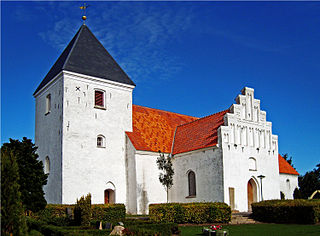
Lisbjerg is a village and suburb 7 km north of the city center of Aarhus, Denmark. Lisbjerg has a population of 1,063.

Alrø is a small Danish island in Horsens Fjord on the east coast of Jutland within Odder Municipality.The island is 7.52 km long with a coastline of 14 km, and stretches a little over 5 km wide from east to west. With a population of 147 as of January 2013, the island can be reached by road over an artificial causeway which connects it to the mainland on the northern side of the fjord. Alrø has been inhabited continuously since the Stone Age up to modern times, with possible additional usage during the Viking Age as a landing site.
Hjarnø is a small Danish island at the mouth of Horsens Fjord on the east coast of Jutland in Hedensted Municipality.
The archaeology of Anglo-Saxon England is the study of the archaeology of England from the 5th Century AD to the 11th Century, when it was ruled by Germanic tribes known collectively as the Anglo-Saxons.
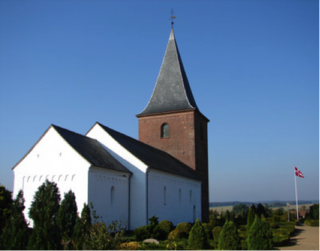
Haldum is a village within the Haldum parish of the Favrskov municipality of mid-Jutland, Denmark, 20 km northwest of Aarhus. The town is home to the medieval-era Haldum Church. In 2004, Haldum Church became known as an archaeological site when the Moesgård Museum conducted excavations in the area surrounding the churchyard, which yielded notable Viking Age and Early Medieval period findings.
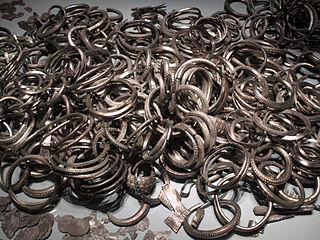
The Spillings Hoard is the world's largest Viking silver treasure, found on Friday 16 July 1999 in a field at the Spilling farm northwest of Slite, on northern Gotland, Sweden. The silver hoard consisted of two parts with a total weight of 67 kg (148 lb) before conservation and consisted of, among other things, 14,295 coins most of which were Islamic from other countries. A third deposition containing over 20 kg (44 lb) of bronze scrap-metal was also found. The three caches had been hidden under the floorboards of a Viking outhouse sometime during the 9th century.
Molnby Hoard is a Viking Age deposit of 163 silver coins found in Molnby, Vallentuna Municipality in Sweden in October 2016. Most of the coins come from the area around Samarkand in Central Asia and date from the 10th century. The hoard is one of the largest Viking Age hoards to have been discovered in the province of Uppland.
The Ubina Hoard is a wealth deposit of silver coins and jewelry found in the village of Salu, Harju County in Estonia in 2005. The oldest items in the hoard probably date from the Viking Age but the hoard seems to have been deposited during the beginning of the 12th century. The archaeological site was subjected to looting the day after its discovery, but coins and jewelry fragments later surfaced in Germany and led to successful legal prosecution of the looter and the return of the looted items to the authorities.
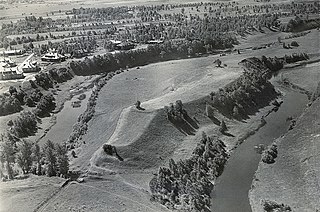
The Viking Age in Estonia was a period in the history of Estonia, part of the Viking Age. It was not a unified country at the time, and the area of Ancient Estonia was divided among loosely allied regions. It was preceded by the Bronze and Early Iron Ages in Estonia, during which an agrarian society had developed, the Migration Period, and Pre-Viking Age with the Viking Age itself lasting between 800–1050 AD. It is often considered to be part of the Iron Age period which started around 400 AD and ended around 1200 AD, soon after Estonian Vikings were recorded in the Eric Chronicle to have sacked Sigtuna in 1187.
Tel Mevorakh is a small mound situated on the southern bank of Nahal Taninim in Israel. The tel does not exceed 1 dunam but rises to a height of 15 metres (50 ft) above its surrounding plain. The site contains some fifteen layers of human settlement, which accumulate to a height of 8 meters, meaning the natural hill does not exceed a height of 7 meters. It is located on the border between the wide Sharon Plain and the coast of Mount Carmel.
Bodzia Cemetery is a large 10th – 11th century chamber burial site in Bodzia, a town in the Kuyavia region of Central Poland, approximately 15 km to the northwest of Włocławek. A group from the Polish Academy of Sciences, led by Polish archaeologist, Andrzej Buko, excavated this site between 2007 – 2009. The excavation uncovered a large elite necropolis containing more than 58 graves, cenotaphs, weapons and riches. The Bodzia Cemetery is considered to be one of the most significant and "spectacular" Early Medieval findings in Poland in the last century. Artefacts uncovered in the site were mostly of foreign origin, which is atypical of other sites in the area. Information gleaned from the Bodzia Cemetery provided archaeologists with evidence of burial practices during the Early Medieval period in Poland.















